Click above for hi-res gallery from the 2008 Baja 500
We did the pre-run, now it was time for Autoblog to race the Baja 500 with driver Chad Hall and Team HUMMER. Our race day start time wasn't until 10:30, but we got to the start line at 8:30. And then we signed autographs and kissed babies. Well, Chad didn't, but people kept asking us for our autograph, so we obliged. Kids also constantly asked for "steeckers," but we didn't have any of those... Follow the jump to see how Autoblog fared as racing co-pilot, and be sure to check out the gallery of hi-res images below and the insane in-truck video after the jump.
We did the pre-run, now it was time for Autoblog to race the Baja 500 with driver Chad Hall and Team HUMMER. Our race day start time wasn't until 10:30, but we got to the start line at 8:30. And then we signed autographs and kissed babies. Well, Chad didn't, but people kept asking us for our autograph, so we obliged. Kids also constantly asked for "steeckers," but we didn't have any of those... Follow the jump to see how Autoblog fared as racing co-pilot, and be sure to check out the gallery of hi-res images below and the insane in-truck video after the jump.
I would be navigating to the first pit stop about 90 miles in wearing my HUMMER race suit and my catheter. Since you don't stop to relieve yourself during the race, that latter contraption is a condom and a rubber tube that runs down your leg and out of your suit so you can do your business in the car and not wet yourself. It isn't very good at what it's supposed to do...
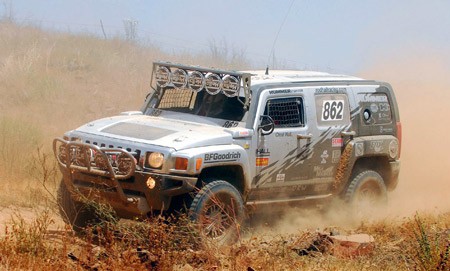
Not that I'd have too much time to worry about bathroom breaks anyway, because there were plenty of other things to keep me occupied. These were my jobs:
- Turn on the tach about three cars before the start.
- Zero out the GPS and start the route guidance at the line.
- Make sure we stayed on the course, and tell Chad whether to go right or left if necessary when the road forked, and to watch out for danger spots marked by a skull-and-bones on the GPS.
- Watch the water temperature to make sure the truck didn't overheat.
- If we got a flat, I would retrieve the spare and put the flat tire away.
- Five miles from the pits I would radio in to let them know we were coming and get our fuel ready.
- Call in the mile markers to the team.
- Blow the horn at slower competitors in front of us.
- Watch the mirrors for vehicles behind us and, when they honked, wave to let them know we'd get out of the way when we could.
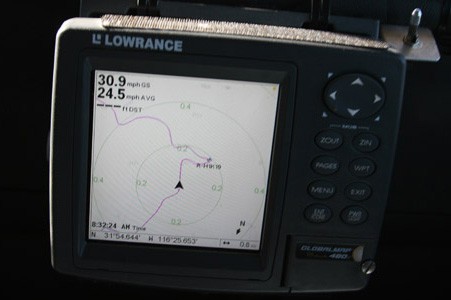
When you get hit by another vehicle, you've been "nerfed," and whatever you do, you want to avoid that. It's hard enough staying on the trail when everything is working properly. Throw a truck-on-truck collision into the mix and you might end up upside-down. Really. So I was told, "Whatever you do keep your eyes on the mirrors and if anyone does honk make sure they see you waving like crazy."
Got it.
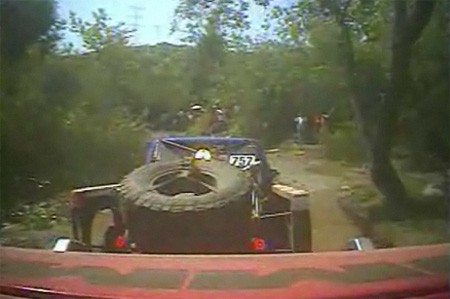
You know you're in deep from the time the start flag drops, but it takes about four minutes to really get the full picture. The start line is in the city, so there are a few 90-degree turns, swtichbacks and doglegs taken at full speed. Then you hit the dirt, which is where the finish line jump is... and you see the 20-deep crowds lining the path, spectators standing in the course to take pictures with their phones... and then the bouncing begins and it never stops... and then you do your first high-rev power slide through rocks and mud... and then, finally, you're out in the open, one a 2-rut trail that snakes every which way, going as fast as you can -- as fast as you can and still win, to be precise...
You fly through and over everything. The clouds of dust are immediate and everywhere, and you fly. The crowds gather in clumps by the jumps and high-speed stretches, and you fly some more, hoping you don't hit anyone on the way down. You fly over humps and hope it's all right on the other side. You fly around tires and other objects placed in the road. You fly by the spectator who is backing up his Ford Expedition on the race course on the far side of a blind corner. You never, ever stop.
Actually, there are three places you don't fly: though hairpin turns, or when you see a skull-and-bones on the GPS, or through silt beds that kick up enough dust to hide the person next to you -- you literally can't see anything. Then you slow down.
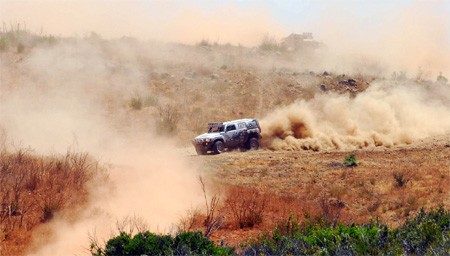
Or you don't, as some competitors chose. Within a few miles we saw vehicles on the side of the road, or over the edges of cliffs. Some of them needed repairs, some of them were just stuck, and some of them were done. Their Baja 500 was actually the Baja 10. One guy even held up his tow rope as we drove by. Hope he's not still waiting.
Still, navigating in that HUMMER was like being the bean in a maraca. And trying to keep track of anything lurking in the dust behind us was a trying task. Your best shot is at switchbacks, when you can kind of see who might be gaining -- unless they're hidden by dust. In that case, first there's nothing and then there's a car right there. Get your hands up and start waving... Not that we had to worry about that much, because on the more technical sections Chad was the gingerbread man: no one was going to catch him.
Different vehicles do well on different kinds of terrain. The trophy trucks and Class One buggies can get up to 100 mph or more on rugged fire trails and washboard, but can be slower than stock class trucks through the tighter stuff and up silt-covered hills. We had been behind one such truck for a while, though the tighter opening sections. When we finally got around him, we raced ahead but missed a turn due to an overnight course change. Stuck behind him again, I blew the horn and almost as soon as I did Chad nerfed him, sending one of the truck's fenders flying off to the left and the truck up a hill and into the brush on the right. Chad said, "I didn't mean to hit him that hard, but he wasn't going to move." That's the Baja.
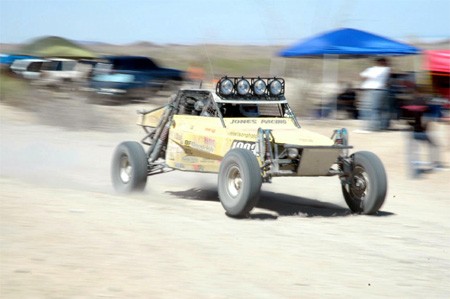
Of course, when we got the next long section of fire trail and whoop-de-doos, who should we see behind us in the distance but the truck Chad knocked off the road. "Watch out for that guy," he said, "he might want revenge."
So here's the scene: you have been in non-stop, high-frequency turbulence through clouds of dust for almost three hours in a roaring HUMMER with no windshield. Your helmet is filled with dust, you've got one ear listening to the team radio, one ear listening to Chad, one eye on the GPS, one eye on the water temperature, one eye looking out for mile markers, and a fourth eye pasted on the mirror watching that big black truck closing in on you (since it might or might not want to catapult you into a gully). And you're wondering if you should pee in your seat to test out this whole catheter nonsense. I can't tell you how much fun it is.
Luckily, we made it to a fork in the road, and when we went left the truck behind us went right. And just as luckily, I didn't try out that catheter, because when I got to the pits I found it had come off.
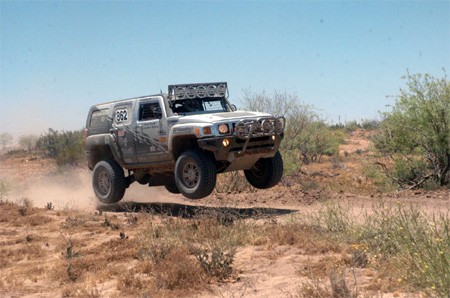
And so we rolled on like that for hours. The truck sounded funny at one point and Chad thought it was a flat tire. I got out and ran around the vehicle, but the tires were fine. Chad said "Let's go!" I got back in, Chad took off. And then I spent the next four miles trying to get my 5-point harness back together. You didn't simply click into a central locking buckle, you had five individual tabs that needed to be hooked together. It was like trying to knit during a plane crash. It took me four miles to get the belt back together.
It was just after that when I had to radio into the pits to let them know we were almost there. The radio was tucked in the front of the roof, and the display barely legible on a clear day when the truck was parked. But in a cloud of dust with a face full of sand and sitting on a rodeo bull, I had to turn that impossible-to-see display from channel from 3 to 9, radio in, and then turn the channel back to 3. I got it done -- eventually -- we got our gas, I swapped with Thad Stump, and Chad was off again.
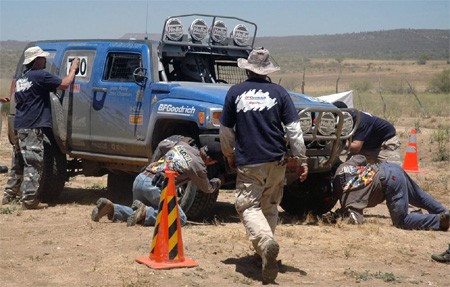
Before the race, I had asked Chad what to do if I wanted to get into desert racing. He said the first thing was just watch a race. His exact words were "You like sex, but if you had to do it for 17 hours without stopping would you really enjoy it all that much?" And let me tell you, he had a point. By the time the first pit came, I was ready to get out. Not because it wasn't awesome, because it was so grand I would do another three hours in that truck again tonight. But I didn't want to do it for the next 12 hours. It would be the equivalent of telling your significant other: "Can't we just cuddle tonight?"
Luckily, Chad and Rod Hall love what they do, which goes a long way in explaining why they won their respective classes. Rod's win made him the winningest Baja 500 driver in its history, with 17 individual victories. Josh didn't fare so well in the H2 -- although we were behind it for a while, let me tell you that mountain can move -- but you can read that story over at PickupTrucks.com, since Mike Levine did 90 miles of third-seat duty. He's got some in-car footage from his truck -- be sure to look out for the newly invented HUMMER gang sign at the end -- and the story of how an H2 becomes a pre-runner.
That's our story from the Baja 500. It was nothing but hot, dirty fun -- if you're into that kind of thing...
The video meant to be presented here is no longer available. Sorry for the inconvenience.
Autoblog does the Baja 500: Round 2, the raceOur travel and lodging for this media event was provided by the manufacturer.
The video meant to be presented here is no longer available. Sorry for the inconvenience.

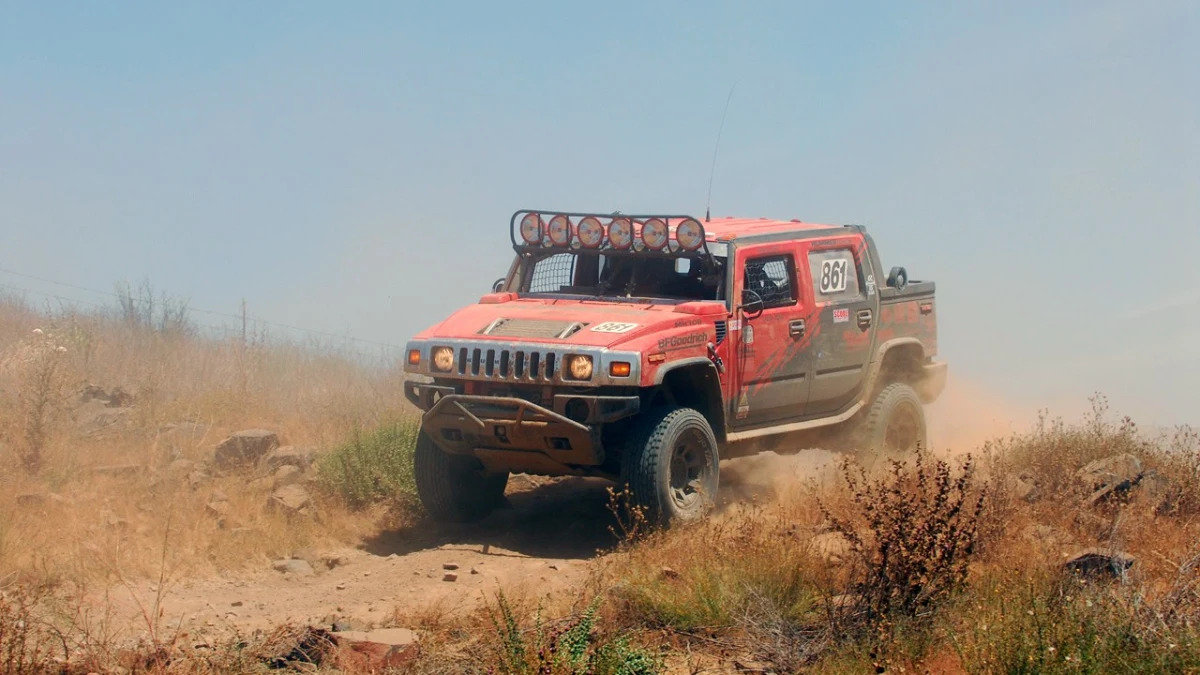

Sign in to post
Please sign in to leave a comment.
Continue